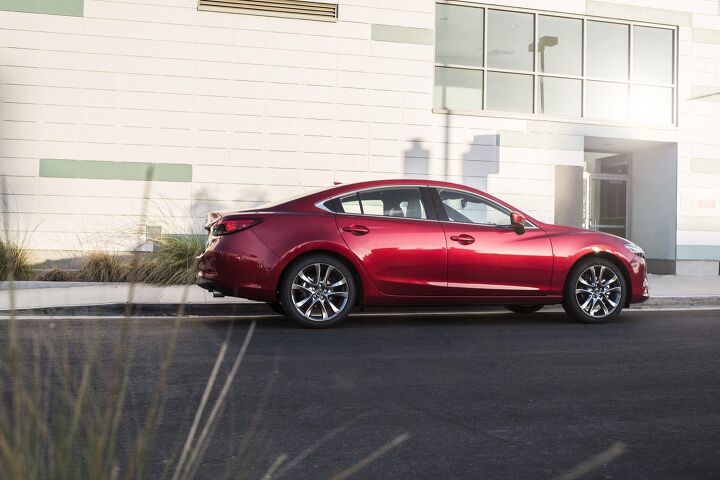Mazda Has No Death Watch For The Mazda 6
Mazda’s U.S. lineup has already suffered enough cutbacks, according to North American boss Masahiro Moro.
“I don’t have any intention to cut any nameplate right now,” Moro told Automotive News following a meeting of the National Dealer Advisory Council earlier in May.
This means the Mazda 6, often thought to be prime Death Watch material based on its low-volume status in the shrinking midsize sedan category, remains as firmly installed in the Mazda showroom as ever.
But where’s the Mazda 6’s replacement? Not on the immediate horizon.
There are key words to pluck out of Moro’s statement to Automotive News’ Michael Wayland.
Intention.
Right now.
You could, if you were as skeptical as TTAC is wont to be, produce a simple translation.
I don’t intend, at the moment, to cut any nameplate. Not at this moment, anyhow.
There’s reason to believe the Mazda 6 isn’t the kind of vehicle a brand might keep around. Only 2 percent of the midsize cars sold in the United States in the first four months of 2017 were Mazda 6s. The 6’s market share hasn’t decreased this year — it’s actually up marginally — because it’s 9-percent rate of year-over-year decline isn’t as drastic as the drop experienced by the overall sector.
U.S. midsize car volume is down by a fifth so far this year.
Numerous low-volume models have already been cut over the last few years, from the Mitsubishi Galant and Suzuki Kizashi to the Dodge Avenger and Chrysler 200. Even when the sales output isn’t obviously small, the task of making money — of successfully selling midsize cars at a price that actually earns a profit — in a segment controlled by a handful of high-volume dominators is particularly challenging. In the case of the Mazda 6, sales have fallen 43 percent since peaking in 2004, just the second full year of the 6’s 626-replacing tenure.
Not surprisingly, when TTAC asked Mazda for timing on the fourth-generation 6’s arrival, the company wasn’t willing to unlock its product planning lair. But the 6, Mazda spokesperson Jacob Brown says, “is one of our global core models.”
Mazda also points to continuous improvements throughout a generation’s lifecycle — the 6’s new interior in 2016, for example, and the installation of G-Vectoring Control for MY2017 — as distinct from mid-cycle refreshes.
With new Camrys and Accords and Altimas due to arrive long before the presently four-year-old Mazda 6 is replaced, Mazda considers these steady improvements to be essential for what will quickly become one of the older designs in the segment.
“Driving the 2014 model back to back with the current one would highlight many improvements, both visible and invisible,” Jacob Brown tells TTAC. The 6 might not be the newest design, Mazda believes, but that doesn’t mean it will feel like the oldest car.
Meanwhile, according to Masahiro Moro, “Our portfolio is clearly in good shape.” Mazda has recently killed off the Mazda 2 subcompact and Mazda 5 minivan in North America. The China-oriented CX-4 and Japan-oriented CX-8 won’t arrive in North America to bolster the brand’s crossover lineup.
And the Mazda 6, like the two more popular Mazdas that produce two-thirds of the brand’s sales, will soldier on.
At least that’s the intention. Right now.
Timothy Cain is a contributing analyst at The Truth About Cars and Autofocus.ca and the founder of GoodCarBadCar.net. Follow on Twitter @timcaincars.
More by Timothy Cain
Latest Car Reviews
Read moreLatest Product Reviews
Read moreRecent Comments
- MaintenanceCosts This engine is a lot less interesting in a nearly-6000-pound Durango than in a 4400-pound Charger. I’ve never understood why this gen of Durango weighs in as heavy as a Wagoneer.
- Aja8888 I knew this would happen sooner or later. Others will follow.
- ToolGuy I read in TTAC that EVs are useless and dead, just sayin.
- ToolGuy I am starting to question the love for our planet expressed by the oligopolists. Have I been lied to?
- NigelShiftright My favorite color on any current car is the "McLaren orange" on Subaru Crosstreks. Unfortunately I am about four inches too tall to fit behind the wheel of one.




































Comments
Join the conversation
I drove the Mazda 6 late last year and really liked it. Unfortunately for Mazda I have a model 3 reserved. I doubt I'm the only one holding off on a car purchase while waiting for Tesla to get going on the Model 3
In my very personal opinion one of the very best looking cars on the market - even more so in the above color. Regretfully, almost everybody says, the rest of it does not quite live up to what one would hope for. Sad.